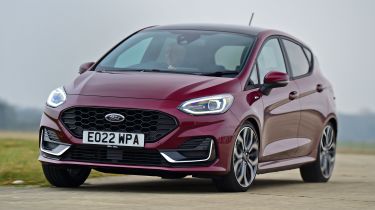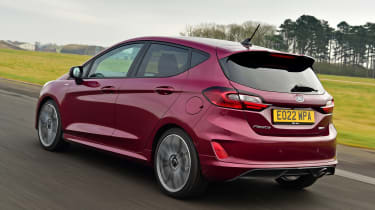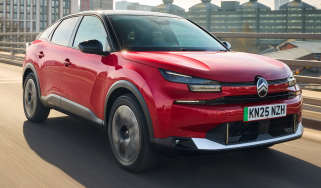Ford Fiesta (2017-2023) review - Engines, performance and drive
Great engines and entertaining handling mean the Fiesta is still fantastic to drive

With the Fiesta, Ford has proved yet again that small, cheap cars can be brilliant fun. The Fiesta might be new, but it will retain its reputation for being fun to drive as it’s better than ever through a series of bends.
Lighter steering in this new model means it’s easier to drive, especially in town, but that doesn’t take away from the driving experience on faster roads. There’s enough weight that you can feel the resistance coming through as you turn into a corner, and the feedback through the wheel means you can place the car on the road with ease. The grippy front-end helps too, as you can throw it in to corners even at high speed without fear of pushing wide.
A throttle lift or touch of braking will tighten the Fiesta’s line, and it’s rewarding to play with the little Ford’s chassis. Body control is very good, and bumps mid-corner don’t upset the balance - but what’s really amazing is that the car combines this agility with an impressively comfortable and composed ride. ST-Line models make things even more composed and fun with only a slight impact on ride quality.
The ride is good even on rutted roads here in Britain, partly because the Fiesta is so light - even the heaviest version is only a touch over 1,200kg. That helps it in so many areas: handling, ride, performance and even economy. Ford’s engineering magic means that even though the Fiesta is around 200kg heavier than the new Suzuki Swift, it feels almost as light on its feet.
Used - available now

2023 Audi
Q4 Sportback e-tron
54,526 milesAutomaticElectric
Cash £23,363
2022 Kia
Niro
18,315 milesAutomaticPetrol1.6L
Cash £17,900
2023 Nissan
Juke
40,858 milesManualPetrol1.0L
Cash £12,287
2022 Volkswagen
T-Roc
36,779 milesAutomaticPetrol1.5L
Cash £18,600The driving position is fantastic, as it feels sporty without being hard to get in and out of, and the steering wheel is just the right size to feel natural as well. The six-speed manual gear change isn’t quite as slick as the one in a Mazda 2, nor as light as the one in the new SEAT Ibiza, but it’s still really easy and fun to switch gears. These things also mean the Fiesta will be enjoyable to drive every day, not just when you find a great road.
Ford has also introduced mild-hybrid tech to the Fiesta range. The 48V system is available on the 1.0-litre 123bhp and (now discontinued) 153bhp petrol engines and helps to increase fuel economy, reduce emissions, while also providing a useful boost in torque.
A six-speed manual transmission is standard for all cars, with the exception of the 1.1L Ti-VCT five-speed manual, and the 123bhp petrol version which is offered with a seven-speed PowerShift auto 'box.
0-62mph acceleration and top speed
Our pick of the engine range is the 1.0-litre EcoBoost three-cylinder petrol engine. It’s been around for a little while now, but remains a top choice because it mixes so many great attributes: it’s punchy, economical and really fun to use all at the same time. It’s quiet as well, matching its rivals for refinement on the move - but without losing the characterful thrum of the three-cylinder engine.
It’s available with 99bhp or 123bhp and all are great options, but make sure you don’t overlook the lowest-powered version in the hunt for more performance. The turbocharger means it’s strong enough in the mid-range, and the 1.0-litre triple’s willingness to rev means it’s great fun to hustle along as well. More powerful versions are - unsurprisingly - more expensive, but the mid-spec variants offer enough pace for most needs.
The 99bhp EcoBoost takes 10.8s to go from 0-62mph, which goes down to 9.4s for the 123bhp engine, while if you track down a used 153bhp version (which is no longer available on the price list) you'll see a 8.9s sprint time. The 1.5T EcoBoost powers the ST-badged cars from 0-62mph in 6.5 seconds, with a 143mph maximum.
The base 1.1-litre three-cylinder petrol with 74bhp and a five-speed manual transmission is considerably slower at 14.7 seconds and doesn’t really offer much in the way of economy savings or improved emissions over the EcoBoost units. It would certainly be a peculiar choice when buyers could look towards the more modern alternatives in the range.













